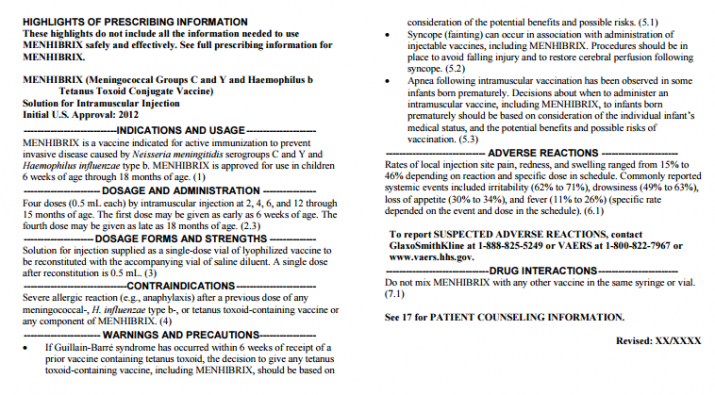
MenHibrix: (Meningococcal Groups C and Y and Haemophilus b Tetanus Toxoid Conjugate Vaccine): patient information, prescribing information, ingredients, manufacturer, adverse reactions and side effects
Tuesday, April 11, 2017 by Gregory Van Dyke
http://www.naturalnewsreference.com/2017-04-11-menhibrix-meningococcal-groups-c-and-y-and-haemophilus-b-tetanus-toxoid-conjugate-vaccine-patient-information-prescribing-information-ingredients-manufacturer-adverse-reactions-and-side-effect.html

HIGHLIGHTS OF PRESCRIBING INFORMATION These highlights do not include all the information needed to use MENHIBRIX safely and effectively. See full prescribing information for MENHIBRIX.
See full insert sheet at this link at the Natural News Reference website.
MENHIBRIX (Meningococcal Groups C and Y and Haemophilus b Tetanus Toxoid Conjugate Vaccine)
Solution for Intramuscular Injection
Initial U.S. Approval: 2012
INGREDIENTS AND EXCIPIENTS
MENHIBRIX (Meningococcal Groups C and Y and Haemophilus b Tetanus Toxoid Conjugate Vaccine), for intramuscular injection, is supplied as a sterile, lyophilized powder which is reconstituted at the time of use with the accompanying saline diluent. MENHIBRIX contains Neisseria meningitidis serogroup C and Y capsular polysaccharide antigens and Haemophilus b capsular polysaccharide (polyribosyl-ribitol-phosphate [PRP]). The Neisseria meningitidis C strain and Y strain are grown in semi-synthetic media and undergo heat inactivation and purification. The PRP is a high molecular weight polymer prepared from the Haemophilus influenzae type b strain 20,752 grown in a synthetic medium that undergoes heat inactivation and purification. The tetanus toxin, prepared from Clostridium tetani grown in a semi-synthetic medium, is detoxified with formaldehyde and purified. Each capsular polysaccharide is individually covalently bound to the inactivated tetanus toxoid. After purification, the conjugate is lyophilized in the presence of sucrose as a stabilizer. The diluent for MENHIBRIX is a sterile saline solution (0.9% sodium chloride) supplied in vials.
When MENHIBRIX is reconstituted with the accompanying vial of saline diluent, each 0.5-mL dose is formulated to contain 5 mcg of purified Neisseria meningitidis C capsular polysaccharide conjugated to approximately 5 mcg of tetanus toxoid, 5 mcg of purified Neisseria meningitidis Y capsular polysaccharide conjugated to approximately 6.5 mcg of tetanus toxoid, and 2.5 mcg of purified Haemophilus b capsular polysaccharide conjugated to approximately 6.25 mcg of tetanus toxoid. Each dose also contains 96.8 mcg of Tris (trometamol)-HCl, 12.6 mg of sucrose, and ≤0.72 mcg of residual formaldehyde. MENHIBRIX does not contain preservatives. The lyophilized vaccine and saline diluent vial stoppers are not made with natural rubber latex.
INDICATIONS AND USAGE
MENHIBRIX is a vaccine indicated for active immunization to prevent invasive disease caused by Neisseria meningitidis serogroups C and Y and Haemophilus influenzae type b. MENHIBRIX is approved for use in children 6 weeks of age through 18 months of age. (1)
DOSAGE AND ADMINISTRATION
Four doses (0.5 mL each) by intramuscular injection at 2, 4, 6, and 12 through 15 months of age. The first dose may be given as early as 6 weeks of age. The fourth dose may be given as late as 18 months of age. (2.3)
DOSAGE FORMS AND STRENGTHS
Solution for injection supplied as a single-dose vial of lyophilized vaccine to be reconstituted with the accompanying vial of saline diluent. A single dose after reconstitution is 0.5 mL. (3)
CONTRAINDICATIONS
Severe allergic reaction (e.g., anaphylaxis) after a previous dose of any meningococcal-, H. influenzae type b-, or tetanus toxoid-containing vaccine or any component of MENHIBRIX. (4)
WARNINGS AND PRECAUTIONS
If Guillain-Barré syndrome has occurred within 6 weeks of receipt of a prior vaccine containing tetanus toxoid, the decision to give any tetanus toxoid-containing vaccine, including MENHIBRIX, should be based on consideration of the potential benefits and possible risks. (5.1)
Syncope (fainting) can occur in association with administration of injectable vaccines, including MENHIBRIX. Procedures should be in place to avoid falling injury and to restore cerebral perfusion following syncope. (5.2)
Apnea following intramuscular vaccination has been observed in some infants born prematurely. Decisions about when to administer an intramuscular vaccine, including MENHIBRIX, to infants born prematurely should be based on consideration of the individual infant’s medical status, and the potential benefits and possible risks of vaccination. (5.3)
ADVERSE REACTIONS
Rates of local injection site pain, redness, and swelling ranged from 15% to 46% depending on reaction and specific dose in schedule. Commonly reported systemic events included irritability (62% to 71%), drowsiness (49% to 63%), loss of appetite (30% to 34%), and fever (11% to 26%) (specific rate depended on the event and dose in the schedule). (6.1)
To report SUSPECTED ADVERSE REACTIONS, contact GlaxoSmithKline at 1-888-825-5249 or VAERS at 1-800-822-7967 or www.vaers.hhs.gov.
DRUG INTERACTIONS
Do not mix MENHIBRIX with any other vaccine in the same syringe or vial. (7.1)
USE IN SPECIFIC POPULATIONS
Pregnancy
Pregnancy Category C
Animal reproduction studies have not been conducted with MENHIBRIX. It is also not known whether MENHIBRIX can cause fetal harm when administered to a pregnant woman or can affect reproduction capacity.
Pediatric Use
Safety and effectiveness of MENHIBRIX in children younger than 6 weeks of age and in children 19 months to 16 years of age have not been established.
Revised: XX/XXXX
https://www.fda.gov/downloads/BiologicsBloodVaccines/Vaccines/ApprovedProducts/UCM308577.pdf
http://naturalnewsreference.com/vaccine-insert-sheets/MenHibrix.pdf
Tagged Under: Tags: dosage, ingredients, insert sheet, menhibrix, side effects, usage, warnings





